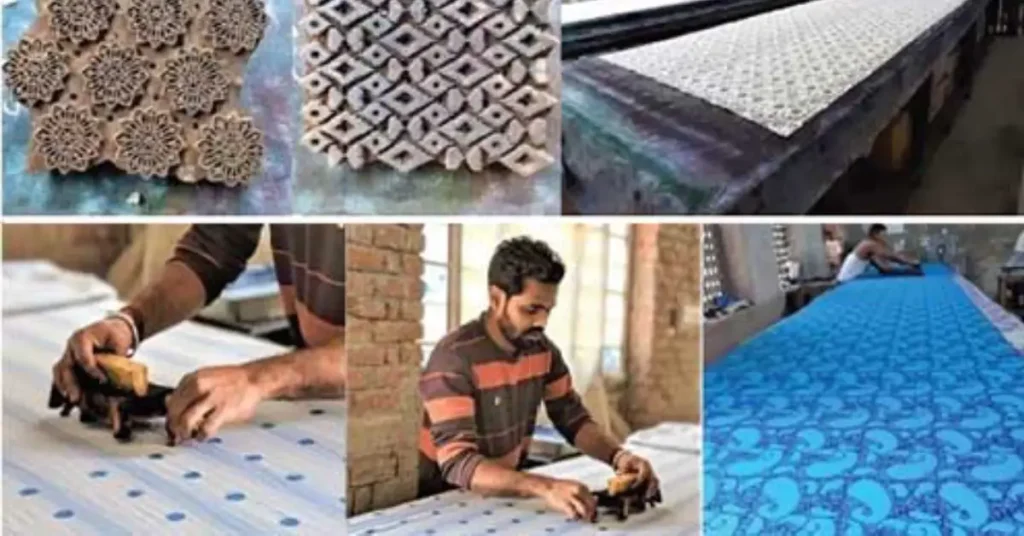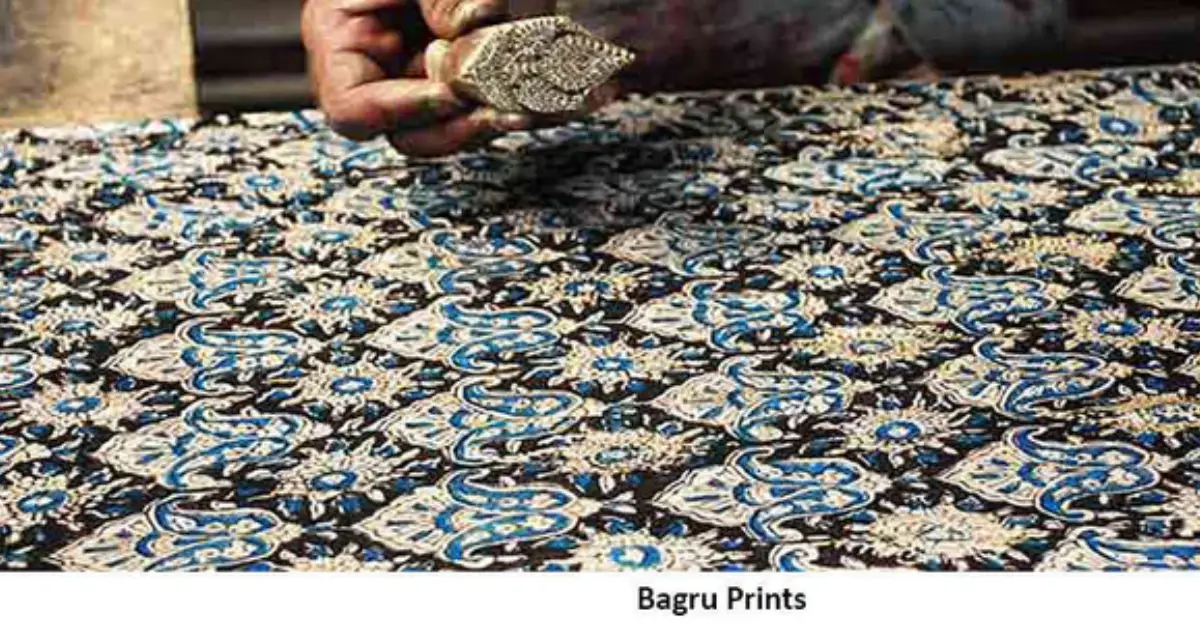Table of Contents
India, a land of vibrant colors and rich traditions, boasts a textile heritage that’s as diverse as it is captivating. Among these treasures lies the exquisite art of Bagru printing, a traditional hand-block printing technique that has been passed down through generations in the small town of Bagru, Rajasthan. These fabrics, with their earthy tones, intricate designs, and sustainable practices, hold a unique charm that continues to captivate both traditionalists and modern designers. Let’s delve into the fascinating world of Bagru prints, exploring their history, techniques, and enduring appeal.
A Journey Through Time: The History of Bagru Prints
Bagru printing has a rich history dating back centuries. The Chippa community, traditional dyers and printers, are the custodians of this art form. It is believed that the craft originated in the region over 300 years ago, though some accounts trace its roots even further back. The abundance of natural resources in the area, including the river and the clay used for the mud resist process, contributed to the flourishing of this craft.
The designs of Bagru prints are deeply rooted in nature and local traditions. Motifs like flowers, leaves, birds, and geometric patterns are commonly used, reflecting the surrounding environment and the cultural beliefs of the community. These designs were not merely decorative; they often carried symbolic meanings, representing elements of nature, prosperity, and spirituality.
Historically, Bagru prints were primarily used to create clothing for the local communities. The earthy tones, derived from natural dyes, blended seamlessly with the desert landscape. Over time, the reputation of Bagru prints spread beyond the region, attracting the attention of traders and connoisseurs. Royal patronage also played a role in promoting the craft, leading to its refinement and diversification.
The Art of Hand-Block Printing: A Labor of Love

Bagru printing is a meticulous and labor-intensive process that requires skill, patience, and a deep understanding of the craft. The entire process is carried out by hand, from the preparation of the fabric to the final printing.
- Fabric Preparation: The process begins with preparing the fabric, usually cotton or silk. The cloth is washed to remove any impurities and then treated with a natural mordant, a substance that helps the dye adhere to the fabric.
- Mud Resist (Dabu): A unique aspect of Bagru printing is the use of “dabu,” a mud resist paste. This paste, made from a mixture of clay, wheat flour, and gum, is used to create the negative space in the design. It is applied to the fabric using wooden blocks, preventing the dye from penetrating those areas.
- Printing: Once the dabu has dried, the fabric is ready for printing. Wooden blocks, carved with intricate designs, are dipped in natural dyes and then pressed onto the fabric. The printer carefully aligns the blocks to create a continuous pattern. Multiple blocks and colors can be used to create complex designs.
- Dyeing: After the printing is complete, the fabric is dyed. The dye penetrates the areas not covered by the dabu, creating the desired pattern. Multiple dyeing processes may be required for multi-colored designs.
- Washing and Finishing: The fabric is then washed to remove any excess dye and the dabu resist. It is then dried and may undergo further finishing processes, such as ironing or calendaring, to enhance its texture and appearance.
The Magic of Natural Dyes: Earthy Hues and Sustainable Practices
One of the most distinctive characteristics of Bagru prints is the use of natural dyes. These dyes are derived from plants, minerals, and other natural sources, giving the fabrics their unique earthy tones and eco-friendly appeal.
- Indigo: Derived from the indigo plant, this dye produces a deep blue color.
- Madder: Extracted from the roots of the madder plant, this dye creates shades of red and orange.
- Turmeric: This spice yields a vibrant yellow color.
- Myrobalan (Haritaki): Used as a mordant, this also imparts a yellowish or brownish hue.
The use of natural dyes not only contributes to the unique aesthetic of Bagru prints but also aligns with sustainable practices. These dyes are generally less harmful to the environment than synthetic dyes, making Bagru printing an eco-conscious craft.
Motifs and Designs: A Language of Symbols
The motifs used in Bagru prints are more than just decorative elements; they are a language of symbols, reflecting the cultural beliefs and traditions of the community.
- Floral Motifs: Flowers like roses, lotuses, and sunflowers are commonly used, representing beauty, purity, and prosperity.
- Leaf Motifs: Leaves of various plants, such as the mango leaf and the peepal leaf, symbolize growth, fertility, and longevity.
- Animal Motifs: Animals like peacocks, elephants, and horses are often depicted, representing strength, wisdom, and royalty.
- Geometric Patterns: Geometric patterns, such as squares, circles, and triangles, are used to create intricate designs and symbolize harmony and balance.
The Modern Appeal: Bridging Tradition and Contemporary Design
While Bagru prints have a rich history and traditional significance, they also possess a timeless quality that makes them relevant in the modern world. Their earthy tones, natural textures, and handcrafted appeal resonate with contemporary design sensibilities.
Bagru fabrics are increasingly being used by fashion designers and interior decorators to create modern garments and home furnishings. The unique charm of these prints adds a touch of cultural richness and artistic flair to contemporary spaces and wardrobes. The sustainable nature of the craft also appeals to environmentally conscious consumers.
Preserving the Legacy: Challenges and Opportunities
Despite their enduring appeal, Bagru printing faces several challenges. The labor-intensive nature of the craft and the competition from cheaper, machine-made textiles threaten the livelihoods of the artisans. The availability of natural dyes and the preservation of traditional knowledge are also crucial concerns.
However, there are also opportunities for the growth and development of Bagru printing. Increased awareness of sustainable and handcrafted products, along with the growing demand for unique and culturally rich textiles, can create new markets for Bagru prints. Government support, collaborations with designers, and the use of technology can also help to revitalize the craft and ensure its survival for future generations.
A Tapestry of Tradition and Innovation:
Bagru printed fabrics are more than just textiles; they are a tapestry woven with threads of history, artistry, and cultural significance. They represent a legacy of craftsmanship, a connection to nature, and a celebration of tradition. As these prints continue to evolve and adapt to the changing times, they will undoubtedly continue to captivate and inspire, bridging the gap between the past and the present, and enriching the world of textiles with their unique charm. By understanding the history, techniques, and modern appeal of Bagru prints, we can appreciate the artistry and dedication that goes into creating these beautiful fabrics and contribute to preserving this precious cultural heritage.
